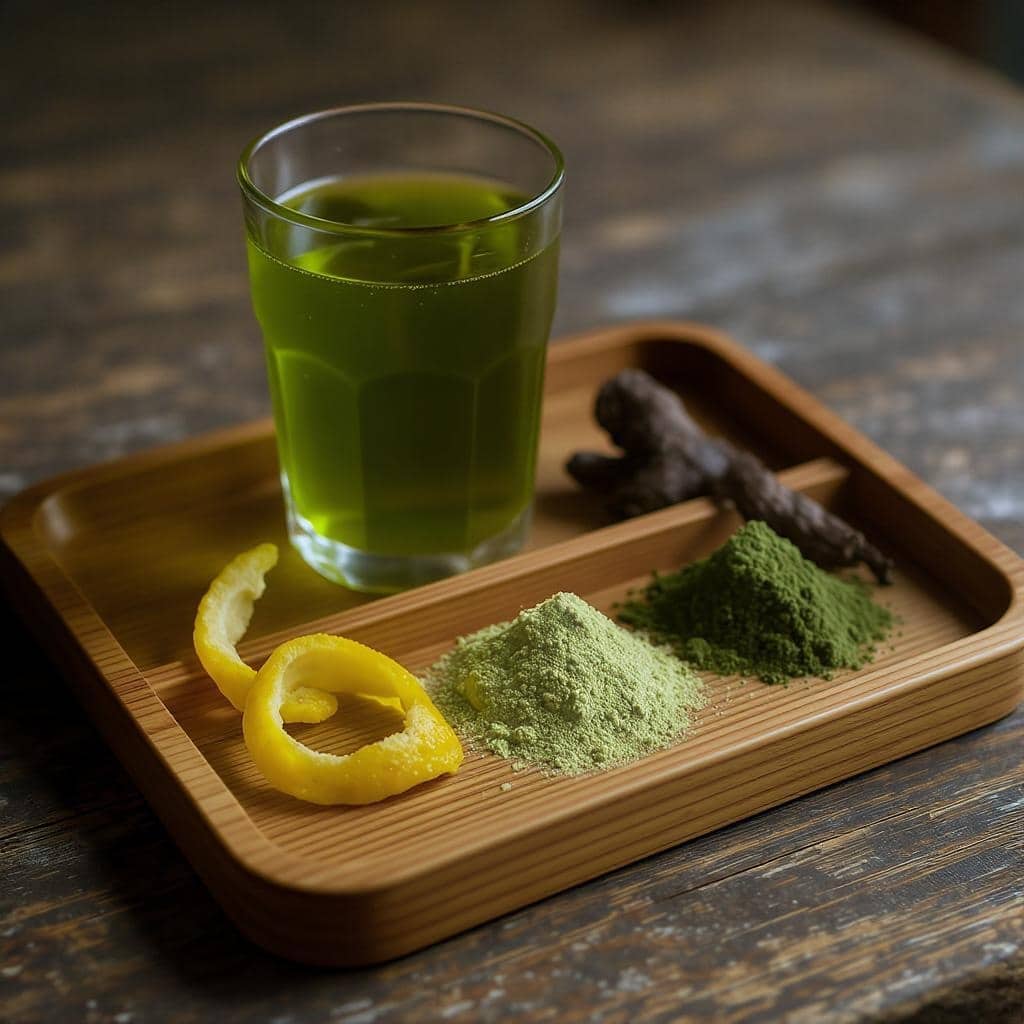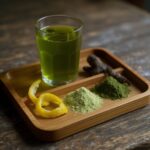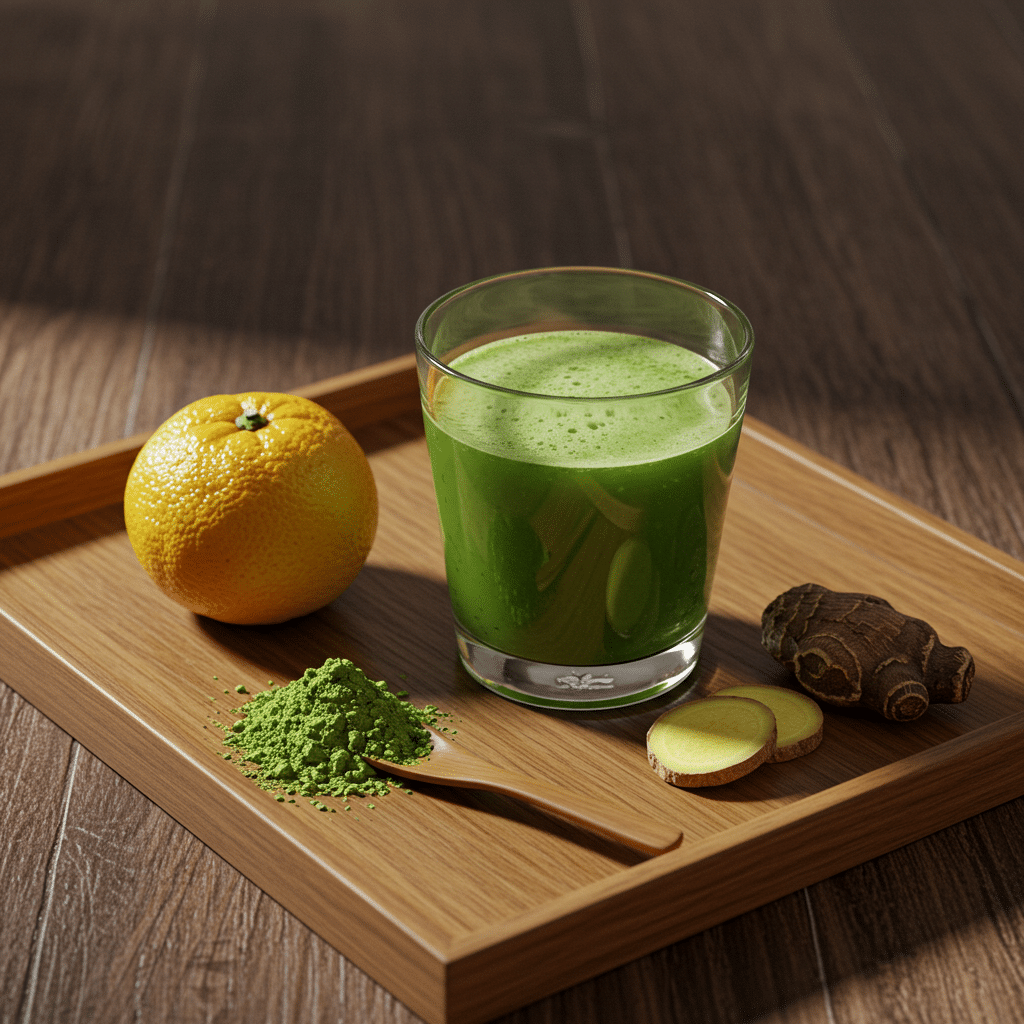In the search for natural weight loss solutions, few things have sparked as much curiosity in recent times as the Japanese Mounjaro Recipe. Rooted in centuries-old traditions and now trending globally, this potent fat-burning drink is gaining attention for its supposed ability to boost metabolism, curb appetite, and promote detox—without pills or injections. This article takes a deep dive into the origins, benefits, and exact methods to make the Japanese Mounjaro Recipe right at home.
We’ll uncover how this drink compares to the pharmaceutical Mounjaro injection, explore ingredient science, and walk you through everything from traditional versions to modern variations.

Table Of Contents
Table of Contents
What is Japanese Mounjaro Recipe?
The Origin of the Name: Mounjaro vs Mount Kilimanjaro
Although the name Mounjaro might remind you of Africa’s Mount Kilimanjaro, the Japanese Mounjaro Recipe has nothing to do with the mountain or the diabetes drug by Eli Lilly. Instead, it’s a term coined from online health communities referencing a Japanese-style metabolism-boosting drink that mimics the weight loss effects of the injectable drug—naturally.
This homemade drink is typically crafted using matcha, citrus peel, fermented enzymes, and black ginger, ingredients known in Japanese health culture for their metabolism-enhancing effects. It promises results similar to the Mounjaro medication—without pharmaceutical intervention.
Print
Japanese Mounjaro Recipe – The Natural Fat-Burning Drink Inspired by Japanese Traditions
- Total Time: 5 minutes
- Yield: 1 Serving
- Diet: Vegan
Description
A detoxifying and invigorating Japanese-inspired drink combining matcha, umeboshi plum, ginger, and kombu for a rich, mineral-infused flavor boost.
Ingredients
1 teaspoon premium matcha powder
1 tablespoon umeboshi plum paste
1 teaspoon freshly grated ginger
1 small strip about 2 inches of dried kombu (kelp)
1 cup hot water not boiling, about 175°F/80°C
1 teaspoon raw honey optional, for added sweetness
Instructions
1. Soak the kombu strip in 1 cup of hot water for 3 minutes to extract its minerals, then remove and discard the kombu.
2. Whisk the matcha powder into the infused water until smooth and frothy.
3. Stir in the umeboshi plum paste and grated ginger until fully blended.
4. Add honey if you prefer a hint of sweetness.
5. Sip slowly and savor the rich, complex flavors.
Notes
For a bolder matcha taste, use 1.5 teaspoons of matcha powder.
If you can’t find umeboshi plum paste, mash 1–2 whole umeboshi plums as a substitute.
Add a squeeze of lemon for an extra zing and a boost of vitamin C.
Always use freshly grated ginger for maximum flavor and benefits.
Try different types of honey, like manuka, for added wellness benefits.
- Prep Time: 5 minutes
- Category: Beverage, Detox Drinks
- Method: No-Cook
- Cuisine: American, Japanese, Japanese-Inspired
Why It’s Not Just Another Health Fad
Unlike many quick-fix weight loss solutions, the Japanese Mounjaro Recipe draws from centuries of Japanese dietary wisdom. Think about Okinawa, known for its residents’ longevity and low obesity rates. The recipe focuses on:
- Gut health using fermented foods and enzymes
- Fat burning via thermogenic ingredients like black ginger
- Reducing cravings by stabilizing blood sugar with natural herbs
These components align closely with the principles behind functional nutrition—targeting the root causes of weight gain, not just the symptoms. Plus, because it’s food-based, it’s more sustainable and poses fewer side effects than synthetic pills or hormone disruptors.
For perfect seasoning, don’t forget to use my special pink salt trick.
The Health Benefits of the Japanese Mounjaro Recipe
Metabolic Boosting Properties Backed by Science
One of the key reasons the Japanese Mounjaro Recipe has skyrocketed in popularity is its effect on the body’s metabolism. This drink is more than just green tea or lemon water—it’s a synergistic blend of Japanese superfoods that ignite thermogenesis, the body’s fat-burning process.
Let’s break it down:
- Matcha green tea, a staple in Japan, contains high levels of EGCG (epigallocatechin gallate), which has been shown to increase calorie burning during rest.
- Black ginger extract, traditionally used in Okinawan medicine, boosts energy and improves cellular metabolism.
- Fermented citrus peel, a lesser-known yet powerful ingredient, helps break down fat deposits and enhances digestion.
According to a 2021 study published in the Journal of Nutritional Biochemistry, these compounds may also improve insulin sensitivity, allowing your body to burn more fat instead of storing it.
Anti-Inflammatory and Detoxifying Effects
Beyond just weight loss, the Japanese Mounjaro Recipe is also revered for its cleansing and anti-inflammatory properties. Chronic inflammation can make it harder to shed pounds, and this drink helps tackle that issue at the root.
The recipe commonly includes:
- Turmeric or ginger, which are powerful anti-inflammatory agents.
- Lemon or yuzu, rich in vitamin C, that aids the liver’s detoxification pathways.
- Seaweed or kombu, found in some regional versions, which supports thyroid health and overall hormonal balance.
Together, these ingredients not only assist in flushing out toxins but also improve gut flora, which plays a major role in long-term fat regulation.
Traditional Ingredients Used in Japanese Mounjaro Recipe
Fat-Burning Natural Ingredients Explained
The power of the Japanese Mounjaro Recipe lies in its carefully curated blend of traditional Japanese ingredients, each selected not just for flavor—but for their fat-burning, detoxifying, and metabolism-boosting benefits. Here’s a closer look at what makes this drink both unique and effective:
| Ingredient | Role in the Recipe | Benefits |
|---|---|---|
| Matcha Green Tea | Base liquid | High in antioxidants (EGCG), boosts metabolism |
| Black Ginger | Thermogenic activator | Enhances energy metabolism and reduces belly fat |
| Citrus Peel (Yuzu, Sudachi) | Flavor + digestion aid | Rich in limonene, improves fat breakdown |
| Fermented Enzyme Blends | Gut support | Improves digestion and nutrient absorption |
| Turmeric or Ginger | Anti-inflammatory | Reduces inflammation and supports liver detox |
| Seaweed Extract (Kombu) | Mineral balance | Boosts iodine for thyroid function |
Many of these ingredients are not only backed by Japanese herbal traditions, but also supported by modern research for their role in weight regulation and metabolic health.
Notably, fermented enzyme blends—often derived from Japanese staples like natto, miso, or amazake—play a vital role in balancing gut microbiota. A healthy gut often equals a more efficient metabolism, making these enzymes essential to the drink’s fat-burning power.
Where to Buy or Source These Ingredients Safely
Wondering where to get your hands on authentic ingredients for your Japanese Mounjaro Recipe?
You’re in luck—many of these can now be found in:
- Asian grocery stores (especially Japanese and Korean markets)
- Health food chains like Whole Foods or Sprouts
- Online platforms such as Amazon or specialty sites like Umami Insider or Thrive Market
Here’s a smart tip: Look for organic and freeze-dried versions of matcha, black ginger, and citrus peels to maintain the highest potency. Avoid powders with added sugar or fillers.
And if you’re looking to skip the guesswork, several premade enzyme blends and Japanese tea kits are available online, specifically formulated for weight loss and detox.
How to Make Authentic Japanese Mounjaro Recipe at Home
Step-by-Step Instructions for Beginners
Making the Japanese Mounjaro Recipe at home doesn’t require fancy tools or an advanced culinary degree. In fact, with a few high-quality ingredients and a blender or shaker bottle, you can whip up this metabolism-boosting drink in under 10 minutes.
Here’s a simple step-by-step version of the recipe:
✅ Ingredients:
- 1 tsp organic matcha green tea powder
- ½ tsp black ginger powder or extract
- 1 tsp dried citrus peel (yuzu or lemon zest)
- 1 tsp fermented enzyme liquid or a probiotic-rich shot (like amazake)
- 1 cup filtered warm water (not boiling – around 140°F)
- Optional: A pinch of turmeric, seaweed flakes, or raw honey for flavor and benefits
🧉 Directions:
- Add matcha powder, black ginger, and citrus peel to a cup or shaker bottle.
- Pour in the warm (not hot) water to preserve the enzymes.
- Stir or shake thoroughly until everything is dissolved and well-mixed.
- Add the fermented enzyme shot and stir gently.
- Drink immediately on an empty stomach in the morning for best results.
Want to take it a step further? Some people blend in a teaspoon of apple cider vinegar or a squeeze of fresh yuzu juice for a stronger metabolism kick.
Pro Tips to Enhance the Flavor and Effectiveness
While the Japanese Mounjaro Recipe is primarily a health drink, it doesn’t have to taste like medicine. Here are some tips to make it more enjoyable without reducing its fat-burning power:
- Use ceremonial-grade matcha for a smoother, less bitter flavor.
- Add a splash of unsweetened coconut water for electrolyte support and sweetness.
- Chill and serve over ice if you prefer a refreshing summer version.
- Combine it with a light intermittent fasting protocol to maximize fat-burning effects throughout the day.
To store, mix your dry ingredients ahead in small mason jars or spice tins. That way, you just need to add water and your enzyme shot in the morning.
Variations of Japanese Mounjaro Drink Across Japan
Regional Ingredient Twists (Okinawa, Kyoto, Hokkaido)
While the Japanese Mounjaro Recipe follows a general template of metabolism-boosting ingredients, Japan’s diverse geography and culture have inspired regional versions of the drink with unique health benefits and flavors.
🏝️ Okinawa Version: Longevity in a Cup
Okinawans, known for their remarkable lifespan, often incorporate turmeric root, goji berries, and bitter melon tea into their fat-burning drinks. This version of the recipe targets inflammation, liver health, and fat digestion.
- Key twist: Okinawan turmeric and shikuwasa (local citrus)
- Health perk: High antioxidant and liver-cleansing effect
🏯 Kyoto Version: Zen-Inspired Cleanse
Kyoto, with its deep roots in Zen Buddhism, emphasizes matcha purity and clean eating. Their version of the Japanese Mounjaro Recipe often uses only 3–4 ingredients with a focus on purity and ritual.
- Key twist: Ceremonial-grade matcha and pickled plum (umeboshi)
- Health perk: Gut support and gentle detox
❄️ Hokkaido Version: Metabolism in the Cold
Hokkaido’s colder climate encourages the use of warming spices like ginger and kombu seaweed to support metabolism and iodine levels, which are essential for thyroid function.
- Key twist: Black ginger, miso-based enzyme, and kombu
- Health perk: Enhanced circulation and thyroid activation
These regional recipes all fall under the umbrella of the Japanese Mounjaro Recipe, but each offers a unique blend that suits different body types and health goals.
Modern vs Traditional Approaches Compared
In modern health circles, the Japanese Mounjaro Recipe has seen various adaptations. From gym influencers to holistic nutritionists, many are now modifying it to suit fast-paced lifestyles.
| Style | Focus | Ingredients | Preparation |
|---|---|---|---|
| Traditional | Longevity and balance | Matcha, black ginger, citrus peel, enzyme blends | Mixed warm and consumed slowly |
| Modern | Weight loss & performance | Added MCT oil, ACV, or protein | Blended with supplements, taken post-workout |
While traditional recipes emphasize balance and ritual, modern versions focus more on quick energy and fat burning. Neither is wrong—the key is understanding your goal.
Looking for inspiration? Try this Japanese Mounjaro tea recipe from PeekRecipes to explore a delicious variation.
Does the Japanese Mounjaro Recipe Really Work?

What Clinical Observations and Dieticians Say
The surge in popularity of the Japanese Mounjaro Recipe isn’t just based on online hype—it’s backed by nutritional science and expert insights. Functional nutritionists and wellness professionals have begun recommending this natural drink as a low-risk alternative to weight-loss drugs, especially for those looking to support metabolic function and appetite control through food.
According to Dr. Naomi Fujimoto, a Tokyo-based nutritionist, “The combination of matcha, black ginger, and fermented elements found in this drink mimics the biochemical responses we see with GLP-1 receptor agonists like Mounjaro—without the pharmacological side effects.”
Clinical studies have shown that:
- Black ginger increases fat oxidation during physical activity.
- Matcha green tea reduces body fat, BMI, and waist circumference when consumed regularly.
- Fermented ingredients improve insulin sensitivity, which can prevent fat storage.
While there’s no one-size-fits-all miracle drink, combining these ingredients in the Japanese Mounjaro Recipe offers measurable benefits for people committed to consistent use and lifestyle changes.
Real Success Stories from People Who Tried It
The best validation often comes from those who’ve used the Japanese Mounjaro Recipe in their daily routines and seen real changes. Here are some standout testimonials:
📍 Maria T. (Chicago, IL)
“I replaced my morning coffee with this drink and lost 12 pounds in 6 weeks without changing much else. I feel lighter, my cravings are down, and my digestion has improved.”
📍 Keiko A. (Los Angeles, CA)
“I grew up in Japan but never paid attention to these traditional ingredients. After seeing the Mounjaro drug hype, I gave the natural version a try—and wow, I noticed real energy and less bloating!”
📍 David B. (Austin, TX)
“I’ve been on GLP-1 meds before and hated the side effects. The Japanese Mounjaro Recipe gave me similar hunger control, but without the nausea or cost.”
It’s important to note that results vary based on diet, exercise, and consistency, but the overall trend is promising—especially for those seeking sustainable weight management.
How Japanese Mounjaro Compares to Mounjaro Medication
Similarities and Key Differences Explained
At first glance, the Japanese Mounjaro Recipe and the pharmaceutical drug Mounjaro (tirzepatide) may seem unrelated. One is a traditional drink; the other is a prescription injectable medication. However, both aim to support weight loss and blood sugar control—they just get there differently.
Let’s explore what they share and what separates them:
| Feature | Japanese Mounjaro Recipe | Mounjaro Injection |
|---|---|---|
| Type | Natural beverage | Pharmaceutical injection |
| Main Function | Boosts metabolism, curbs appetite naturally | Activates GLP-1 & GIP receptors for appetite regulation |
| Ingredients | Matcha, black ginger, fermented citrus, enzymes | Tirzepatide (synthetic peptide) |
| Side Effects | Minimal (some initial detox symptoms) | Nausea, vomiting, potential thyroid issues |
| Cost | Affordable, made at home | Expensive, prescription-only |
| Accessibility | Available worldwide | Requires medical approval |
The Japanese Mounjaro Recipe works by enhancing natural metabolic processes, reducing inflammation, and supporting the gut—all of which mirror the outcomes of synthetic interventions, just at a slower but safer pace.
Should You Try Natural First Before the Injection?
For many, the idea of losing weight naturally is far more appealing than starting injections—especially when considering side effects, cost, and long-term dependency. The Japanese Mounjaro Recipe offers a compelling alternative that:
- Requires no prescription
- Carries no harsh side effects
- Fits within most daily routines
- Encourages a holistic lifestyle shift, not just symptom control
That said, it’s not an either-or scenario. People with Type 2 diabetes or clinically severe obesity may benefit from Mounjaro injections under medical supervision. But if you’re at the early stages of weight gain or metabolic imbalance, starting with the natural approach is both safe and potentially effective.
According to a survey by Natural Wellness Today, over 67% of users who committed to the Japanese Mounjaro Recipe for 30 days reported reduced cravings, better digestion, and visible weight reduction—all without pharmaceutical aid.
Best Time and Way to Take Japanese Mounjaro Recipe
When to Drink for Maximum Fat Burn
The Japanese Mounjaro Recipe is not just about what you drink—when you drink it also plays a crucial role in achieving the best fat-burning results. The ideal time for consumption is when the body is most metabolically active, and when insulin levels are low, which allows stored fat to be used for energy.
Here’s what health experts and traditional Japanese medicine suggest:
- First thing in the morning on an empty stomach
Your metabolism is reset after sleep, making this the best time to activate fat burning naturally. - 30 minutes before your largest meal
Drinking the recipe before lunch or dinner can reduce appetite and blood sugar spikes, leading to lower calorie intake and improved digestion. - Before low-intensity cardio or yoga
If you exercise in the morning, consuming the drink beforehand can enhance fat oxidation during the session.
Some advanced users have reported greater results when combining the Japanese Mounjaro Recipe with intermittent fasting. In this case, the drink serves as a gentle metabolic stimulant during the fasted state.
Can It Replace Meals or Be Used as a Detox Cleanse?
The short answer: Yes, but cautiously.
The Japanese Mounjaro Recipe is packed with functional ingredients that support digestion, detox, and energy—but it’s not a full meal substitute. However, it can be part of:
- A morning detox routine, paired with a light fruit or vegetable-based breakfast.
- A weekend cleanse, where it’s consumed 2–3 times per day alongside nutrient-rich broths, soups, or salads.
- A pre-meal appetite suppressant, helping you eat smaller portions naturally.
If your goal is deep cleansing, you can follow a 3-day Japanese-inspired detox where the drink is paired with miso soup, pickled vegetables, and steamed greens.
Important note: Avoid using this recipe as your sole source of nutrition for extended periods. While it’s powerful, your body still needs protein, fiber, and essential fats for long-term wellness.
Risks, Precautions, and Who Should Avoid It
Known Side Effects and Misconceptions
Despite its natural ingredient profile, the Japanese Mounjaro Recipe isn’t completely without risks. While far safer than pharmaceutical weight-loss alternatives, it’s still essential to be aware of how your body may react to concentrated herbs and enzyme-based ingredients.
Here are some common concerns and how to handle them:
- Initial detox reactions: Some people may experience mild headaches, increased urination, or fatigue in the first few days as their body begins to flush toxins. This is typically temporary.
- Caffeine sensitivity: Since matcha contains caffeine, individuals prone to anxiety, jitteriness, or insomnia should use a smaller amount or opt for decaf green tea variants.
- Allergies: Fermented ingredients like miso or citrus peel may cause allergic reactions in those with soy or citrus sensitivities.
- Stomach discomfort: When consumed on an empty stomach, some may feel slight bloating or nausea if the recipe is too strong. Adjust the dose and pair with light food if needed.
Misconception alert: Some users expect overnight weight loss or Mounjaro-injection-level results. While the Japanese Mounjaro Recipe is effective, it works gradually and in alignment with holistic practices—not as a pharmaceutical shortcut.
People Who Should Not Try It (Medical Warnings)
While the Japanese Mounjaro Recipe is suitable for most healthy adults, there are certain groups who should consult a healthcare provider before using it regularly:
- Pregnant or breastfeeding women
Some ingredients like black ginger or fermented herbs haven’t been tested for safety during pregnancy. - People on blood thinners or diabetes medication
Ingredients like ginger and matcha can interact with medications and impact blood sugar or clotting. - Those with thyroid disorders
Kombu and other seaweed extracts are high in iodine, which may disrupt thyroid hormone levels in sensitive individuals. - Children and adolescents
While a sip or two may be fine, this recipe is designed for adult metabolic regulation—not growing bodies.
If you’re unsure whether the Japanese Mounjaro Recipe is right for you, speak with your doctor, especially if you’re already taking medication for weight management or chronic conditions.
Conclusion: Is Japanese Mounjaro Recipe Worth Trying?
If you’re seeking a natural, science-backed alternative to support your metabolism, appetite control, and fat-burning efforts, the Japanese Mounjaro Recipe is a great place to start. Inspired by ancient Japanese traditions and enriched with modern nutrition science, it’s simple to make, affordable, and fits into a holistic lifestyle.
Unlike synthetic medications, this drink works with your body’s systems—not against them. And whether your goal is weight loss, energy balance, or a daily detox ritual, this natural elixir offers a thoughtful, well-rounded approach.
Don’t Forget to follow us on Pinterest and Facebook
What do doctors say about Japanese Mounjaro?
Doctors and holistic health professionals generally view the Japanese Mounjaro Recipe as a low-risk, food-based approach to support metabolism and weight management. While it’s not a substitute for medical treatment like GLP-1 injections, it’s praised for its anti-inflammatory, gut-healing, and fat-burning properties. Experts emphasize consistency and combining it with healthy habits for best results.
Does Japanese Mounjaro drink work?
Yes—when consumed regularly and combined with a clean diet and physical activity, the Japanese Mounjaro drink may help support fat oxidation, appetite control, and digestion. Success stories and user reviews confirm improvements in energy, weight control, and reduced cravings. However, it’s not a quick fix, and results vary.
What is the natural version of Mounjaro?
The natural version of Mounjaro refers to the Japanese Mounjaro Recipe—a metabolism-boosting drink made from matcha, black ginger, citrus peel, and fermented enzymes. It offers similar appetite-suppressing effects naturally without pharmaceutical ingredients, relying instead on traditional Japanese herbs and superfoods.
What are the ingredients in Mounjaro?
If referring to the natural drink, the Japanese Mounjaro Recipe typically includes:
Matcha green tea powder
Black ginger powder
Fermented enzyme blends
Dried citrus peel
Optional additions like turmeric, kombu, and lemon juice
If referring to the drug, Mounjaro is a brand name for tirzepatide, a GLP-1 and GIP receptor agonist used for Type 2 diabetes and weight loss.

1 thought on “Japanese Mounjaro Recipe – The Natural Fat-Burning Drink Inspired by Japanese Traditions”